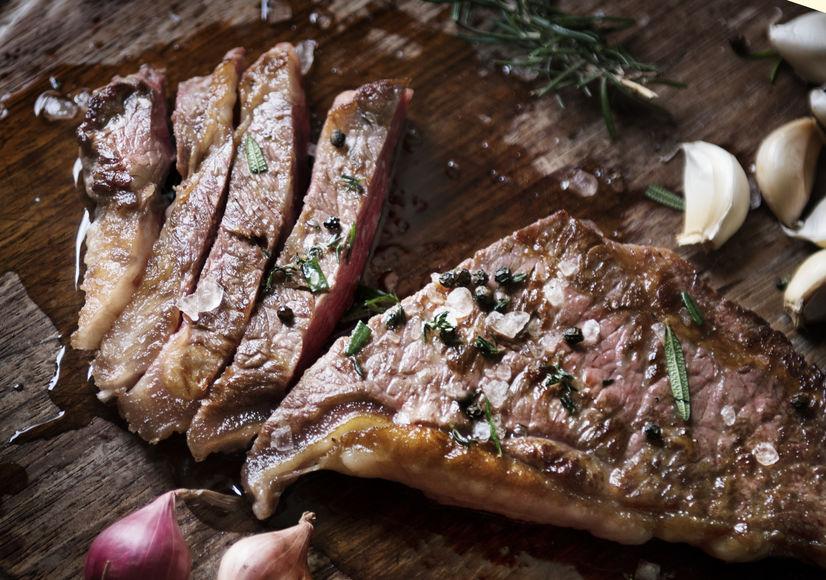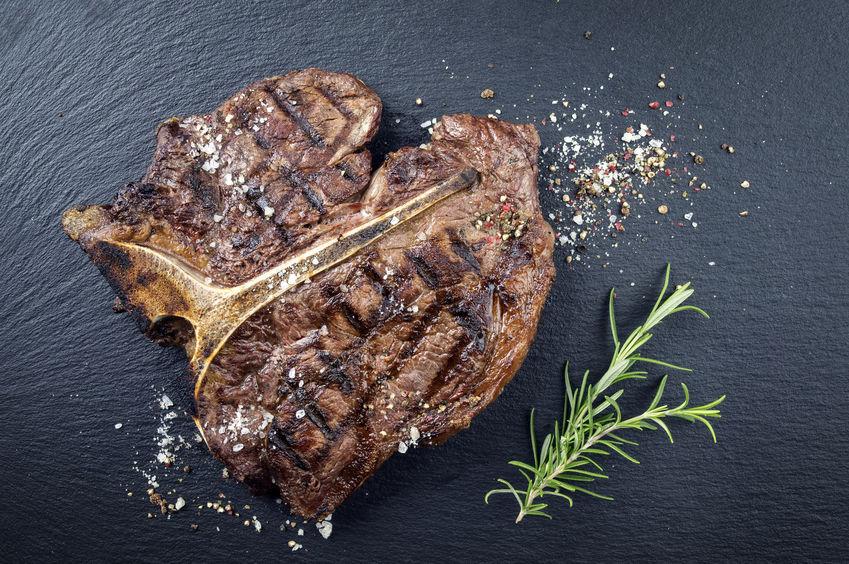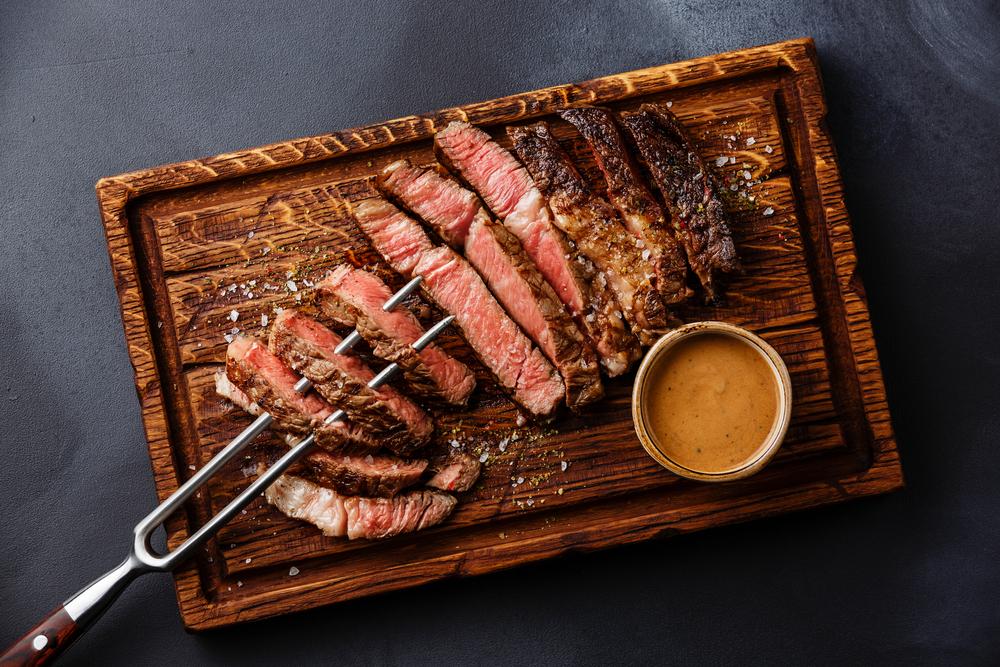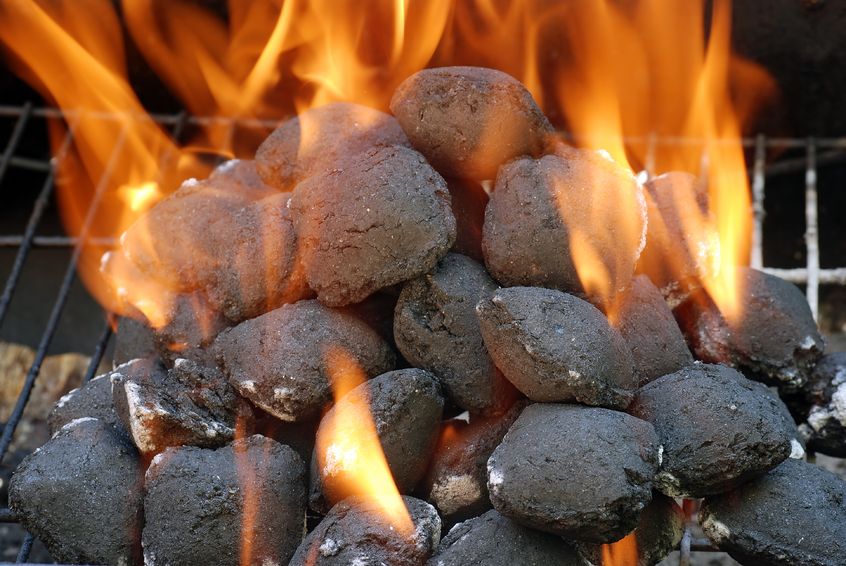This content has been archived. It may no longer be relevant

Steak and charcoal grilling are a match made in culinary heaven.
The high-intensity heat of hot coals creates a perfect crispy sear, while the juices that vaporize in the firebox add unparalleled flavor and complexity to the steak.
To truly elevate your grilling game, it’s crucial to choose the right cut of steak for charcoal grilling.
Not all steaks are created equal, as you may have discovered while cooking on your grill.
Here are the best steak cuts for charcoal grilling, and how you can bring out the best in them.
Rib Eye Steaks – A Premium Cut for Charcoal Grilling

Rib eye steaks are a high-quality cut of meat that are ideal for charcoal grilling.
Their rich flavor, thickness, and marbling make them perfect for achieving a juicy and tender result on the grill.
Charcoal grilling imparts a smoky flavor that complements the natural taste of rib eye steaks, while also allowing for precise temperature control.
The result is a visually appealing and deliciously flavored steak that is sure to impress at any meal.
- Flavor. Rib eye steaks are known for their rich, beefy flavor. The marbling, or intramuscular fat, in rib eye steaks gives them a tender and juicy texture, and when cooked on a charcoal grill, the fat melts and bastes the steak, enhancing the flavor profile.
- Thickness. Rib eye steaks are usually cut thick, typically around 1 to 1.5 inches. This thickness allows for a perfect sear on the outside while keeping the inside juicy and tender. Charcoal grilling provides high heat that can quickly sear the exterior of the steak, locking in the juices and creating a delicious crust.
- Charcoal Flavor. Cooking rib eye steaks on a charcoal grill imparts a distinct smoky flavor that complements the natural flavor of the meat. The smoke from the charcoal adds depth and complexity to the taste of the steak, elevating the overall dining experience.
- Versatility. Rib eye steaks are versatile and can be cooked to different levels of doneness, from rare to well-done, depending on your preference. Charcoal grilling allows for precise temperature control, giving you the ability to achieve your desired level of doneness with ease.
- Presentation. Rib eye steaks are visually appealing with their marbling and charred grill marks, making them an impressive centerpiece for any meal. Cooking rib eye steaks on a charcoal grill can create a beautiful caramelized crust on the outside, while keeping the inside tender and juicy.
In conclusion, rib eye steaks are a premium cut of meat that pairs perfectly with the smoky flavors of charcoal grilling.
The combination of rich flavor, thickness, charcoal flavor, versatility, and impressive presentation make rib eye steaks an excellent choice for grilling on charcoal for a truly elevated dining experience.
Tenderloin Steaks – Tender and Neutral

Tenderloin steaks, also known as filet mignon, are a cut of meat that is prized for its tenderness and mild flavor.
Here’s a brief introduction to why tenderloin steaks are known for their tender and neutral characteristics.
- Tender. Tenderloin steaks come from the tenderloin muscle, which is located in the loin of the animal and does not bear much weight. This lack of exercise results in a very tender cut of meat that is highly desirable for its melt-in-your-mouth texture. Tenderloin steaks require minimal effort to chew and are often considered one of the most tender cuts of beef.
- Lean. Tenderloin steaks are known for their leanness, as they have less marbling (intramuscular fat) compared to other cuts of beef. This makes them a popular choice for those seeking a leaner cut of meat. However, the lower fat content can also result in a milder flavor compared to other cuts of beef.
- Neutral Flavor. Tenderloin steaks have a mild, subtle flavor that is often described as “neutral” or “buttery.” The lack of marbling means that tenderloin steaks do not have a strong beefy taste like other cuts, making them a versatile option that can be easily paired with various seasonings, sauces, and accompaniments.
- Versatility. The neutral flavor of tenderloin steaks makes them highly versatile in the kitchen. They can be cooked to different levels of doneness, from rare to well-done, and can be easily adapted to various cooking methods, such as grilling, pan-searing, or roasting. Tenderloin steaks are often considered a luxurious choice for special occasions or a blank canvas for culinary creativity.
- Presentation. Tenderloin steaks are known for their elegant presentation. They are typically cut into thick, round medallions and are often served as individual steaks, making them visually appealing and perfect for special occasions or fine dining experiences.
In summary, tenderloin steaks are prized for their tenderness, lean profile, neutral flavor, versatility, and elegant presentation.
Whether you prefer a simple preparation or want to experiment with different seasonings and techniques, tenderloin steaks offer a delicious and refined option for those seeking a premium cut of meat.
Sirloin Steaks – A Great All-Round Steak for Grilling

Sirloin steaks are a popular cut of beef that are known for their versatility and flavor, making them a great option for grilling.
Here’s a brief introduction to why sirloin steaks are considered a great all-round steak for grilling.
- Flavor. Sirloin steaks have a robust, beefy flavor that is often described as bold and hearty. The moderate marbling (intramuscular fat) in sirloin steaks adds flavor and juiciness to the meat when cooked on a grill, resulting in a delicious and satisfying steak.
- Versatility. Sirloin steaks come from the sirloin primal cut, which is located towards the rear of the animal and is divided into several different cuts, such as top sirloin, bottom sirloin, and sirloin tip. This makes sirloin steaks versatile, as they can be prepared in different ways and offer various levels of tenderness and flavor profiles depending on the specific cut.
- Texture. Sirloin steaks have a good balance of tenderness and chewiness, making them enjoyable to eat. They are not as tender as cuts like tenderloin or rib eye, but they still offer a satisfying meaty texture that many steak enthusiasts appreciate.
- Cooking. Sirloin steaks are well-suited for grilling due to their thickness and structure. They are typically cut into thick steaks, allowing for a good sear on the outside while keeping the inside juicy and flavorful. Sirloin steaks can be cooked to various levels of doneness, from rare to well-done, and are forgiving when it comes to cooking times and temperatures.
- Value. Sirloin steaks are often considered a more affordable option compared to premium cuts like tenderloin or rib eye, making them a great choice for those who want a delicious steak without breaking the bank. Despite being relatively more budget-friendly, sirloin steaks still offer a great flavor and texture that can rival higher-priced cuts.
In conclusion, sirloin steaks are a versatile and flavorful option for grilling, making them a popular choice for many steak lovers.
Their robust flavor, versatility, enjoyable texture, and reasonable price point make them a great all-round steak that can be a delicious addition to any grilling menu.
Porterhouse Steaks – The Best of Both Worlds

Porterhouse steaks are a premium cut of beef that are often referred to as “the best of both worlds” due to their unique combination of two other popular cuts, the tenderloin and the New York strip.
Here’s a brief introduction to why porterhouse steaks are considered a top choice for steak enthusiasts.
- Size. Porterhouse steaks are known for their large size and thickness, typically ranging from 1 to 2 inches in thickness. This generous thickness allows for a great sear on the outside while keeping the inside juicy and tender, making them a favorite among steak aficionados.
- Combination of Cuts. Porterhouse steaks consist of two parts: the tenderloin on one side and the New York strip on the other, separated by a T-shaped bone. The tenderloin is known for its unparalleled tenderness, while the New York strip offers a robust, beefy flavor. Having both cuts in one steak provides a perfect balance of tenderness and flavor, offering the best of both worlds for steak lovers who enjoy both qualities.
- Flavor. Porterhouse steaks have a rich, bold flavor that comes from the well-marbled New York strip portion of the steak. The marbling adds juiciness and flavor to the meat, resulting in a mouthwatering steak with a savory taste profile.
- Cooking Options. Porterhouse steaks can be cooked using various methods, such as grilling, pan-searing, or broiling, and can be cooked to different levels of doneness, from rare to well-done, depending on personal preference. The thickness of porterhouse steaks allows for versatility in cooking, with the option to sear the outside and achieve a perfect medium-rare or medium internal temperature.
- Presentation. Porterhouse steaks are often considered a show-stopping cut due to their size and presentation on the plate. When cooked and served whole, porterhouse steaks make an impressive centerpiece for a special meal or a special occasion, making them a popular choice for celebratory dinners or gatherings.
In summary, porterhouse steaks offer a winning combination of tenderness, flavor, and presentation, making them a top choice for steak connoisseurs.
Their unique blend of the tenderloin and New York strip, along with their size and versatility in cooking, make porterhouse steaks a sought-after cut of meat for those who appreciate the best of both worlds when it comes to steak.
Maximize Flavor With the Right Grilling Temperature and Doneness

Grilling is a popular cooking method that can produce deliciously flavorful steaks when done correctly.
One key factor in maximizing flavor when grilling steaks is getting the right temperature and doneness.
Here’s a brief overview of how temperature and doneness can affect the flavor of your grilled steaks.
- Temperature. The temperature at which you grill your steaks can greatly impact their flavor. To achieve a perfectly grilled steak with maximum flavor, it’s important to preheat your grill to the right temperature. For most steaks, a medium-high to high heat is recommended, typically around 400-450°F (204-232°C). This high heat helps to sear the outside of the steak, locking in the juices and creating a flavorful crust. If the grill is not hot enough, the steak may end up steaming instead of searing, resulting in a less flavorful result.
- Doneness. The doneness level of your grilled steak can also affect its flavor. Different levels of doneness, ranging from rare to well-done, offer different flavor profiles. For example:
- Rare. A rare steak will have a cool, red center and will be very juicy and tender. The flavor will be more pronounced, with a stronger beefy taste.
- Medium-rare. A medium-rare steak will have a warm, pink center and will still be very juicy and tender. The flavor will be slightly less pronounced than rare, but still rich and beefy.
- Medium. A medium steak will have a pink center with a little less juice, but still remain tender. The flavor will be slightly milder compared to rare or medium-rare, but still enjoyable.
- Medium-well/well-done. As the steak cooks longer, it will have less pink in the center and will be firmer and less juicy. The flavor will be more subdued, with less pronounced beefy notes.
- Resting. Allowing your grilled steaks to rest for a few minutes after cooking is another important factor in maximizing flavor. Resting allows the juices to redistribute within the meat, resulting in a more evenly flavored and juicy steak. Tent your steaks with foil and let them rest for about 5-10 minutes before slicing and serving.
- Seasoning. Seasoning your steaks with salt and pepper or other herbs and spices before grilling can also greatly enhance their flavor. The high heat of the grill will help to caramelize the seasonings on the outside of the steak, adding depth and complexity to the flavor profile.
Achieving the right grilling temperature, doneness level, resting time, and seasoning can all play a crucial role in maximizing the flavor of your grilled steaks.
Experimenting with different temperatures and doneness levels can help you find the perfect balance of flavor that suits your taste preferences
Does the Type of Charcoal Affect the Steak?

Yes, the type of charcoal used in grilling can affect the flavor of the steak.
Charcoal is made from different materials, such as hardwood, coconut shells, or briquettes, and each type of charcoal can impart a unique flavor to the food being grilled.
Here are some common types of charcoal and how they may affect the flavor of the steak.
- Hardwood Charcoal. Made from natural hardwood, such as oak, hickory, or mesquite, hardwood charcoal is known for its strong and distinct smoky flavor. When used in grilling, it can infuse the steak with a rich, smoky taste that can add depth and complexity to the flavor profile of the meat.
- Lump Charcoal. Lump charcoal is made from chunks of hardwood that have been charred, and it tends to burn hotter and faster than briquettes. It can impart a more pronounced smoky flavor to the steak due to its natural and irregular shape, which allows for better airflow and more intense heat.
- Briquettes. Briquettes are made from compressed charcoal dust or other additives, such as binders and fillers. They are typically more consistent in shape and size, and they tend to burn longer and at a more even temperature compared to lump charcoal. Briquettes may have added flavorings, such as mesquite or hickory, which can subtly influence the taste of the steak.
- Coconut Shell Charcoal. Coconut shell charcoal is made from the shells of coconuts and is known for burning hotter and cleaner than other types of charcoal. It has a milder flavor compared to hardwood charcoal and may not impart as strong of a smoky taste to the steak.
It’s important to note that the type of charcoal used is just one factor that can influence the flavor of the steak.
Other factors such as the type of wood chips or chunks used for smoking, the seasoning and marinades applied to the steak, and the cooking technique and temperature also play a role in the overall flavor profile of the grilled steak.
Ultimately, the type of charcoal used can add a unique flavor dimension to the steak, and experimenting with different types of charcoal can be a fun way to customize and enhance the taste of your grilled steaks to suit your personal preferences.
Bottom Line – What’s the Best Steak for Charcoal Grilling?
 In conclusion, there are several excellent steaks that are well-suited for charcoal grilling, each with its own unique characteristics and flavor profiles.
In conclusion, there are several excellent steaks that are well-suited for charcoal grilling, each with its own unique characteristics and flavor profiles.
The best steak for charcoal grilling ultimately depends on personal preference and desired taste.
- Rib Eye Steaks. With its marbling and rich, beefy flavor, rib eye steaks are a popular choice for charcoal grilling. The high fat content of rib eye steaks helps keep them juicy and flavorful when cooked over charcoal, resulting in a deliciously tender and flavorful steak.
- Tenderloin Steaks. Tenderloin steaks, also known as filet mignon, are prized for their tenderness and mild flavor. They are a great option for those who prefer a milder, more delicate taste in their steak, and they can be a good choice for charcoal grilling as well, as they can be cooked quickly over high heat.
- Sirloin Steaks. Sirloin steaks are versatile and well-rounded steaks that offer a balance of tenderness and flavor. They can be a great all-around option for charcoal grilling, as they are typically leaner than rib eye or tenderloin steaks and can benefit from the smoky flavor of charcoal.
- Porterhouse Steaks. Porterhouse steaks offer the best of both worlds with their combination of tenderloin and New York strip cuts. Their large size, thickness, and rich flavor make them a premium option for charcoal grilling, providing a satisfying and impressive steak experience.
Ultimately, the best steak for charcoal grilling depends on individual taste preferences, budget, and desired flavor profiles.
Experimenting with different cuts of steak, temperatures, and cooking times can help you find the perfect steak for your charcoal grilling adventures and create a memorable and delicious meal.
